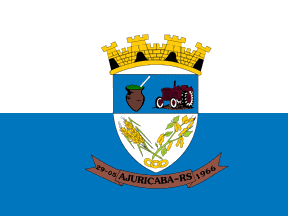 image by Paulo RS Menezes, 29 May 2014
image by Paulo RS Menezes, 29 May 2014Source: http://commons.wikimedia.org/wiki/Category:Flags_of_municipalities_of_Rio_Grande_do_Sul

Last modified: 2014-06-14 by ian macdonald
Keywords: rio grande do sul | ajuricaba |
Links: FOTW homepage |
search |
disclaimer and copyright |
write us |
mirrors
 image by Paulo RS Menezes, 29 May 2014
image by Paulo RS Menezes, 29 May 2014
Source:
http://commons.wikimedia.org/wiki/Category:Flags_of_municipalities_of_Rio_Grande_do_Sul
Based on
http://www.ajuricaba.rs.gov.br/paginas/dados_historicos, the municipality of
Ajuricaba (7,255 inhabitants in 2010; 32,324 ha) is located 30 km north-west of
Ijui and 450 km north-west of Porto Alegre. Ajuricaba is named for an Amazonian
cacique of the Manaos tribes. In the beginning of the 17th century, he set up an
alliance with the Dutch against the Portuguese. To prevent a Dutch invasion of
the Rio Negro valley, the Portuguese attacked the Manaos. Captured in 1727,
Ajuricaba committed suicide by drowning during his transfer to Belém. Ajuricaba
has remained an archetypical freedom fighter both for the natives and the
Portuguese.
Ajuricaba was established by German and Italian immigrants,
coming from old colonies of Rio Grande do Sul, such as Bento Gonçalves and São
Leopoldo. The new colony, established on 19 October 1890, as Colônia de Ijuhy
Grande, was the first of the new colonies founded in north-western Rio Grande do
Sul. The colony, originally divided into "lines", was subsequently organized in
districts and renamed Ajuricaba in January 1940. The municipality of Ajuricaba
was established on 8 November 1965 by Decree-Law No. 5,085 and inaugurated on 29
May 1966, with its seat at Linha 19.
The symbols of Ajuricaba are
prescribed by Municipal Law No. 237, adopted on 10 May 1978. The flag is
horizontally divided into two equal parts, the upper white and the lower
celestial blue. In the middle of the flag is placed the municipal coat of arms.
The coat of arms is "Per fess, 1. Azure a mate gourd and a tractor proper,
2. Argent a wheat plant and a soybean plant proper crossed per saltire in base
three chain links or. The shield surmounted by a four-towered mural crown or
masoned and ports sable. Beneath the shield a scroll maroon inscribed '29.05 /
AJURICABA - RS / 1966' in letters sable."
The mate gourd symbolizes a main
local resource and highlights the town's traditions and hospitality. The tractor
symbolizes agriculture and the mechanization of field work. Wheat and soybean
are the main source of income in the municipality. Their union symbolizes
cooperativism. The chain links recall the native peoples. The four towers stands
for a "cidade".
Ivan Sache, 31 May 2014